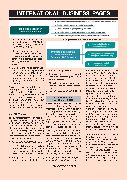INTERNATIONAL BUSINESS PAGES for China or 692 for the US) or in- dustrial designs (over 200,000 for the EU; less than 50,000 for the US and 20,000 for China). •The T&C industry is challenged for its environmental impact, in particu- lar its use of natural resources, ap- plication of hazardous chemicals and significant amount of textiles waste. •COVID19 has shaken the founda- tions of the textiles, apparel and fashion industry. Global supply chains have been disrupted, retail- ers are restructuring their sourcing options, consumer behaviour is changing. Against this background, EU policy makers put a strong focus on the T&C sector: a dedicated “EU Sustainable Textiles Strategy” is to be published by the European Commission before the end of 2021, and a “transition pathway” will be developed for the textiles sec- tor, as one of the 14 critical ecosys- tems of the EU’s new Industrial Strat- egy. EURATEX Vision The current context offers an opportu- nity to shape a new European frame- work for the T&C industry, which is at a crossroad. EURATEX wants to con- tribute actively to this process, to make sure we can develop a forward-looking business model, laying the foundations for a competitive and sustainable Eu- ropean textiles industry.Looking forward, EURATEX ambition is to : source of competitiveness. •Emphasises the value of a skilled workforce, embracing new green and digital skills. •Maintains its support for open mar- kets, based on free but fair compe- tition. Looking forward, EURATEX ambition is to : A Global Leader on Sustainable Textiles Sustainability should become a source of competitiveness. For this to materialise, a constructive dialogue with EU policy makers is necessary. Several legislations (e.g. Waste Frame- work Directive, REACH, etc.) or up- coming policies (e.g. Consumer Agenda, Sustainable Product initiative, etc.) have already set, in theory, progress for sustainable textiles. •EURATEX strives for a recognition of the Textiles & Clothing (T&C) sector as an essential and strate- gic part of the European economy.However, from the industry perspec- tive these laws/policies could signifi- cantly harm the industry’s competitive- ness or capacity to produce; besides there is no evidence that these laws may fully achieve the intended goals. Therefore, the textile strategy should roll out measures to support the legis- lation implementation while boosting the industry competitiveness. •Strongly believes in innovation, quality and sustainability as aMore specifically, EURATEX proposes to work on the following measures:In line with the EURATEX Charter, NCM-OCTOBER 2021 561. Circular and sustainable products need to be clearly recognised and identified, based on common Eu- ropean – preferably global – stan- dards, labels and verifiable calcu- lation methods. Transparency and traceability (tools) are necessary, but should be carefully tested on their intended use and be product- specific. We should therefore de- velop and adopt a Product Environ- mental Footprint (PEF) which is SME friendly and not a burden, and avoid multiplication of standards, which can be overlapping and gen- erate an inflation of company au- dits. The progress on traceability and PEF tools should be reviewed against real-life applicability, interoperability, reliability and effec- tiveness. Also new taxonomy rules must benefit sustainable invest- ment, without becoming directly or indirectly a challenge for SMEs. 2. To share the cost of the circular transition and keep the competitive- ness of responsible European busi- nesses, EURATEX proposes to guide those countries who decide to develop EPR schemes and to ensure coherence across the EU. We should also make sustainability a (positive) business case for the textile industry: implementing an EU-wide bonus system based on
